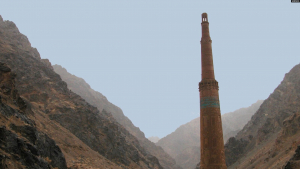
FILE: The Minaret of Jam, a UNESCO World Heritage Site, dates back to 1190.
In Afghanistan, preserving the Silk Road may literally be the path to peace. Home to some of the world’s ancient civilizations, the areas comprising Afghanistan today have been at the crossroads of most of world history.
Preserving Afghanistan’s cultural heritage — including archeological sites, cultural artifacts, and immaterial attributes of its diverse cultures — can boost tourism and help promote tolerance and understanding in the country. Cultural preservation is central to nation-building and vital at a time when Afghans hope for a return to stability amid ongoing peace efforts.
If there is a silver lining to the recent floods in northwestern Afghanistan, it is this: a fervent push by the Afghan government and UNESCO to protect archeological monuments. UNESCO pledged $2 million to preserve the 12th-century Minaret of Jam, which was threatened by floodwaters. Such projects are paramount, but they must be complemented by an educational drive.
The sociopolitical significance of cultural heritage is tied to memory and power. Consider the desired outcome of the Taliban’s demolition of Buddha statues in Afghanistan’s Bamiyan Valley or the destruction of Palmyra in Syria by the Islamic State (IS) militants. If history is the story the past tells, their acts sought to delete entire chapters. The objective was to erase any cultural heritage inconsistent with their ideals and vision. By compelling a national amnesia, they can re-engineer social memory so that future generations grow up and identify with a narrative that supports the very basis of their power. Afghans need to know and accept who they are, factually and empirically, before they are sold myths bent on destruction and division.
The question of identity underscores nation-building. Whether for a country or an individual, identity is expressed by association — to values, places, and people. When the connection between the past and the present becomes tenuous, populations lose common ground. Afghanistan is a hapless paradigm: Years of war have led to ethnic and sectarian divisions fueled by reconstructions of historical memory. With much of the archeological record destroyed or looted, powerbrokers and warlords fill the vacuum with insular narratives of ethnic or linguistic superiority that belie Afghanistan’s rich cultural background.
At present, Afghanistan has only two UNESCO World Heritage sites: the area around the Minaret of Jam in Ghor Province and the archeological site in Bamiyan Valley. These represent two disparate but equally significant epochs in Afghanistan. The minaret is a legacy of the Ghurid Empire, which spanned Afghanistan and parts of Central Asia, Iran, Pakistan, and India and whose rulers converted to Islam from Buddhism in the 12th century. They erected the monument in honor of their newfound faith. What they did not do was destroy Buddhist relics, which they would have found idolatrous. As such, the Bamiyan Valley on the famed Silk Road contains archeological remains layered with Roman, Greek, Indian, and Sasanian cultural inputs. These hybrid influences are evident in the Buddhist art that developed during the Gandharan civilization circa 500 B.C. in modern-day northern Pakistan and Afghanistan. Unlike the distant past, the post-Soviet period in Afghanistan, marked by the civil war among the mujahedin leaders and the rise of the Taliban in the 1990s, speaks to a relatively recent history of cultural property desecration.
To turn the tide, Afghanistan needs a robust cultural heritage protection and educational program. Security is understandably a formidable challenge to archeological excavations. But if and when possible, the program should be a national priority. Currently, the National Museum of Afghanistan in Kabul is certainly a valuable asset, despite having been robbed of much of its value during the wars. In the future, investment in local anthropological museums would help educate Afghans, particularly in more remote areas, about how fascinatingly diverse and significant their cultural experience has been in the region — underscoring clear evidence of co-existence, cultural and social interchange, and tolerance among populations who practiced different religions and spoke diverse languages.
As in many other countries around the world, preserving Afghanistan’s cultural heritage will inevitably attract tourists. The sector was starting to take off before war broke out in the late 1970s. If peace returns to the country, small investments in tourism will guarantee major returns.
In addition, the Afghan government, with international assistance, could implement a corresponding public education campaign that reinforces the unity of Afghans through a shared, multifaceted cultural heritage. Is it costly? Yes. Is it in the realm of possibility? Also, yes. It need not replace quick-impact economic development programs, which are undoubtedly necessary. But Afghanistan can marshal its own resources as well as those in the diaspora who can serve as historians, anthropologists, and archeologists — and investors. In the long term, restoring Afghanistan’s identity and dignity to its own people and the world is worth the challenge and the cost. It could serve as a bulwark in preventing another civil war. But perhaps a population that is able to fully understand its cultural heritage can realize what is truly at stake and pause when it matters most.
Lastly, cultural heritage preservation and education should not be an afterthought in the fanfare surrounding mining and extractives. The industry is key to Afghanistan’s economic development and should be developed responsibly. In fact, it presents an optimal opportunity for the Afghan government to enforce cultural resource management (or museum development) among investors. Resistance among some foreign investors is guaranteed, but that should not be a deterrent. What is the alternative? Not conducting proper stakeholder engagements? Giving a green light to bulldoze over historical sites or buried artifacts? Whatever value can be extracted from such projects, there is yet greater value in the history it uncovers. Any measure conducted at its expense will surely erode chances at lasting peace and prosperity.